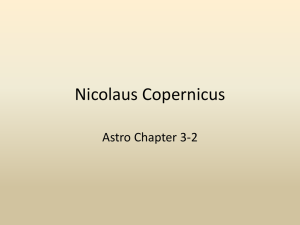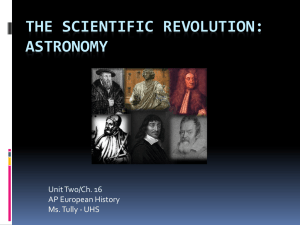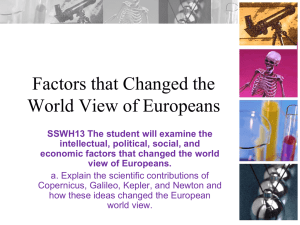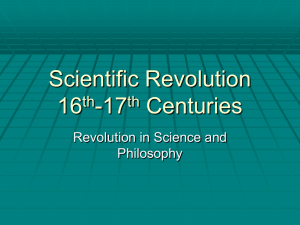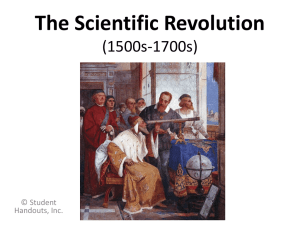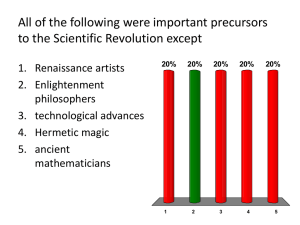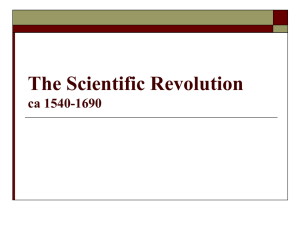Chapter 8 ID Cards
advertisement
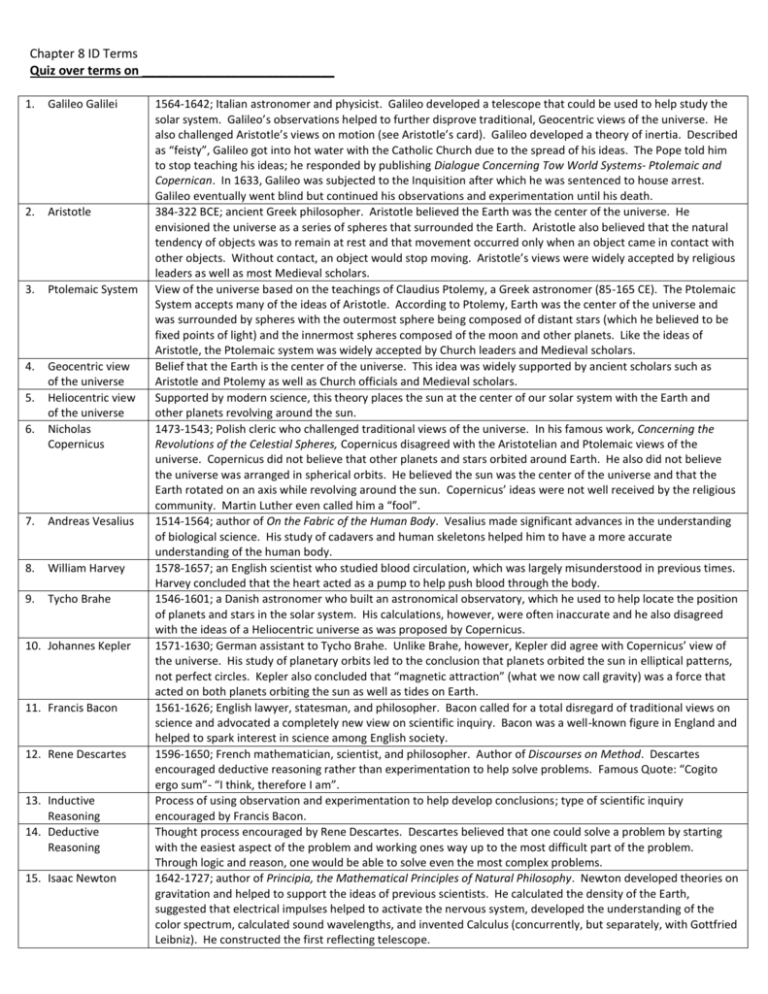
Chapter 8 ID Terms Quiz over terms on ____________________________ 1. Galileo Galilei 2. Aristotle 3. Ptolemaic System 4. Geocentric view of the universe Heliocentric view of the universe Nicholas Copernicus 5. 6. 7. Andreas Vesalius 8. William Harvey 9. Tycho Brahe 10. Johannes Kepler 11. Francis Bacon 12. Rene Descartes 13. Inductive Reasoning 14. Deductive Reasoning 15. Isaac Newton 1564-1642; Italian astronomer and physicist. Galileo developed a telescope that could be used to help study the solar system. Galileo’s observations helped to further disprove traditional, Geocentric views of the universe. He also challenged Aristotle’s views on motion (see Aristotle’s card). Galileo developed a theory of inertia. Described as “feisty”, Galileo got into hot water with the Catholic Church due to the spread of his ideas. The Pope told him to stop teaching his ideas; he responded by publishing Dialogue Concerning Tow World Systems- Ptolemaic and Copernican. In 1633, Galileo was subjected to the Inquisition after which he was sentenced to house arrest. Galileo eventually went blind but continued his observations and experimentation until his death. 384-322 BCE; ancient Greek philosopher. Aristotle believed the Earth was the center of the universe. He envisioned the universe as a series of spheres that surrounded the Earth. Aristotle also believed that the natural tendency of objects was to remain at rest and that movement occurred only when an object came in contact with other objects. Without contact, an object would stop moving. Aristotle’s views were widely accepted by religious leaders as well as most Medieval scholars. View of the universe based on the teachings of Claudius Ptolemy, a Greek astronomer (85-165 CE). The Ptolemaic System accepts many of the ideas of Aristotle. According to Ptolemy, Earth was the center of the universe and was surrounded by spheres with the outermost sphere being composed of distant stars (which he believed to be fixed points of light) and the innermost spheres composed of the moon and other planets. Like the ideas of Aristotle, the Ptolemaic system was widely accepted by Church leaders and Medieval scholars. Belief that the Earth is the center of the universe. This idea was widely supported by ancient scholars such as Aristotle and Ptolemy as well as Church officials and Medieval scholars. Supported by modern science, this theory places the sun at the center of our solar system with the Earth and other planets revolving around the sun. 1473-1543; Polish cleric who challenged traditional views of the universe. In his famous work, Concerning the Revolutions of the Celestial Spheres, Copernicus disagreed with the Aristotelian and Ptolemaic views of the universe. Copernicus did not believe that other planets and stars orbited around Earth. He also did not believe the universe was arranged in spherical orbits. He believed the sun was the center of the universe and that the Earth rotated on an axis while revolving around the sun. Copernicus’ ideas were not well received by the religious community. Martin Luther even called him a “fool”. 1514-1564; author of On the Fabric of the Human Body. Vesalius made significant advances in the understanding of biological science. His study of cadavers and human skeletons helped him to have a more accurate understanding of the human body. 1578-1657; an English scientist who studied blood circulation, which was largely misunderstood in previous times. Harvey concluded that the heart acted as a pump to help push blood through the body. 1546-1601; a Danish astronomer who built an astronomical observatory, which he used to help locate the position of planets and stars in the solar system. His calculations, however, were often inaccurate and he also disagreed with the ideas of a Heliocentric universe as was proposed by Copernicus. 1571-1630; German assistant to Tycho Brahe. Unlike Brahe, however, Kepler did agree with Copernicus’ view of the universe. His study of planetary orbits led to the conclusion that planets orbited the sun in elliptical patterns, not perfect circles. Kepler also concluded that “magnetic attraction” (what we now call gravity) was a force that acted on both planets orbiting the sun as well as tides on Earth. 1561-1626; English lawyer, statesman, and philosopher. Bacon called for a total disregard of traditional views on science and advocated a completely new view on scientific inquiry. Bacon was a well-known figure in England and helped to spark interest in science among English society. 1596-1650; French mathematician, scientist, and philosopher. Author of Discourses on Method. Descartes encouraged deductive reasoning rather than experimentation to help solve problems. Famous Quote: “Cogito ergo sum”- “I think, therefore I am”. Process of using observation and experimentation to help develop conclusions; type of scientific inquiry encouraged by Francis Bacon. Thought process encouraged by Rene Descartes. Descartes believed that one could solve a problem by starting with the easiest aspect of the problem and working ones way up to the most difficult part of the problem. Through logic and reason, one would be able to solve even the most complex problems. 1642-1727; author of Principia, the Mathematical Principles of Natural Philosophy. Newton developed theories on gravitation and helped to support the ideas of previous scientists. He calculated the density of the Earth, suggested that electrical impulses helped to activate the nervous system, developed the understanding of the color spectrum, calculated sound wavelengths, and invented Calculus (concurrently, but separately, with Gottfried Leibniz). He constructed the first reflecting telescope. Chapter 8 ID Terms Quiz over terms on ____________________________
